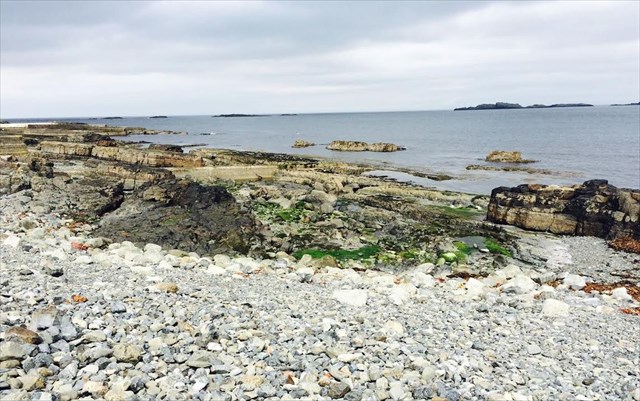
The Neptunists versus The Vulcanists
The Neptunists believes that the rocks here were sedimentary, formed in an ancient ocean. The Vulcanists considered evidence from a variety of sites, including the nearby Giant’s Causeway, and believed that these rocks originated as molten magma or lava cooling to product the basalts and granites seen here.
There was overwhelming evidence from around Europe which supported the Vulcanist view (which is also a view that modern geologists support), however the Neptunists identified the rocks at Portrush as definitive evidence supporting their view. These rocks looked like basalt, but contained fossil remains of past animal life (mainly ammonites, a now extinct group related to squids). The Nepunists asked how could a formerly molten rock have supported life? It looked for a while as if Portrush could be the site that would result in ‘victory’ for the Neptunists and defeat for the modernising Vulcanists.
Some of the most important geologists of that time visited the Portrush site and proved that the fossil bearing rocks were not basalt at all but were, in fact, sedimentary rock of Jurassic age which had been altered by the later development of the Portrush Sill, a huge mass of igneous rock that Portrush is now built on. The heat and pressure from this molten rock baked the adjacent fossil rich rocks making them appear similar to basalt.
Within the geological community, this debate was seen as the point at which modern geology dates from, where field evidence was used to refute conceptual approaches to geology. Some geologists even regard the rocks at Portrush as the single most important geological locality in the world.

The rocks appearing here are in fact Liassic Shale and the fossils embedded within tell us that these rocks were here approximately 150 million years before the basalt which was deposited on top.
Liassic Shale
Shale is a fine-grained, clastic sedimentary rock composed of mud which is a mix of clay minerals and other tiny mineral fragments. Shale is typically grey in colour but can be black, dependent on the amount of minor constituents.
Liassic Shale dates from the Lower Jurassic Period, which began 201.3 million years ago and ended 174.1 million years ago.
Theft of Portrush Rocks
In July 2014, sixteen rocks believed to contain samples of the ammonite fossils were stolen from the nature reserve. The site is an important geological area and the fossils contain little or no commercial value. PLEASE DO NOT REMOVE ANY FOSSIL SAMPLES YOU MIGHT FIND HERE.
Sources:
http://www.northernireland.gov.uk/
http://www.bbc.co.uk/news
To log this earthcache as a find, please complete the following tasks:
1. What type of rock is shale? Igenous, sedimentary or metamorphic?
Stage one:
2. In what year was it proven that volcanic rock had forced its way between the beds of sedimentary rock ?
3. The geologist who proved this was from Scotland: what city was he from?
Stage two:
4. Describe the different colours and textures of rocks you can see when you look towards the sea from this spot.
Explore the rocks….
5. Can you find any fossils? If yes, please describe the appearance of the fossil you find. Optional: feel free to upload any pics of the fossils you find.
Important: PLEASE DO NOT REMOVE ANY FOSSILS FROM THE BEACH.
Do not wait to log your find. As soon as you have emailed me the answers via my profile, please log the cache. I will contact you if there are any issues with your answers.
Happy Earthcaching!